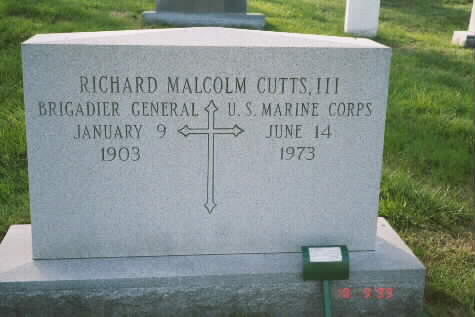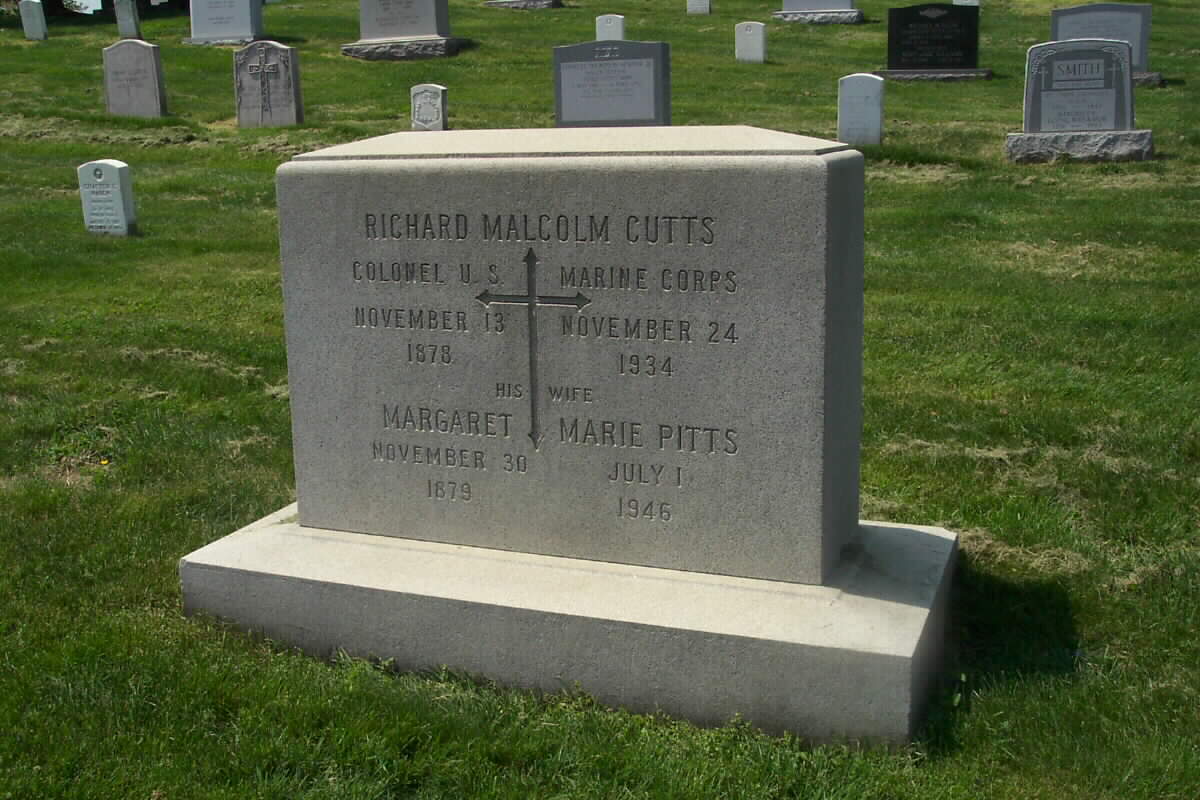From a contemporary press report:
“It is with profound regret that the Association announces the passing of this popular and distinguished officer.
This soldier-inventor was a native Californian, born at Mare Island on November 13, 1878, and raised in the midst of the environment of the Old Navy, the son of Lieutenant Commander Richard M. Cutts, USN.
He was an Ensign in the Navy during the war with Spain and in July 1899 was made a Second Lieutenant in the United States Marine Corps, in 1900 a Captain, in 1903 a Major and in 1916 and 1917 a Lieutenant Colonel and in 1922 a Colonel.
His career approached what a Marine officer so desires, namely a well-rounded one. His service took him to the Philippines in 1903, to Cuba in 1912, to Honolulu in 1915. He was aide to the Commander in Chief of the Pacific Fleet in 1918, from which assignment he went to command the 10th Regiment at Quantico, Virginia, and, following this assignment, be became Fleet Marine Officer of the Atlantic Control Force. In 1923 and 1924 he had the very important assignment of Commandant of the Santo Domingo National Army.
It was during this assignment that he organized the defensive arm for the Dominican government, and such organization remains intact. Colonel Cutts has often said that he considered this special service the best service he has given to his country. His last foreign duty was as a Brigade commander in Haiti. Upon his return to the United States in 1931, he was assigned duty at the Naval War College, Newport, Rhode Island. He remained on the staff of this institution until he was placed on leave, and remained on leave at the time of his death.
He will be remembered by the fact that he invented and perfected the Cutts Compensator, a device which alleviates the shock transmitted upon firing a gun or rifle. The Cutts Compensator was aaccepted by our Government and is also in use by several foreign governments.
His services afforded him the privilege of wearing five campaign medals. He was the proud possessor of two letters of commendation, one from the Secretary of War, and one from the Secretary of the Navy, for his soldierly qualities and administrative abilities. He was recommended by the Major General Commandant for the advancement to the grade of Brigadier General, but his health could not permit him to enjoy this advancement.
The passing of Colonel Cutts will be sad news to the many friends he made during his 35 years of service. He was buried at Arlington National Cemetery on November 30, 1934, his funeral being attended by high-ranking officers from the Army, Navy and Marine Corps.”
He was born on November 13, 1878 and died on November 24, 1934 and is buried in Section 2 of Arlington National Cemetery.
COLONEL RICHARD CUTTS, USMC, DIES AT 56
Saw Service in World War, The Conflict With Spain and in Haiti and San Domingo
SAN DIEGO, California, November 24, 1934 – Colonel Richard M. Cutts, USMC, died today at his home here after a long illness. His was 56. Burial will take place in Arlington National Cemetery near Washington.
Colonel Cutts came here from Newport, Rhode Island, two months ago. He served as an Ensign in the Navy during the Spanish-American War and was appointed to the Marine Corps in 1899. During the World War he was on the staff of the Commander-in-Chief of the Pacific Fleet. From 1922 to 2924 he commanded the National Police of Santo Domingo and later headed the First Brigade in Haiti.
Surviving are a widow, Mrs. Margaret Pitts Cutts of San Diego; a daughter, Mrs. Alice Wainwright of Washington, and a son, Lieutenant R. M. Cutts, USMC.
CUTTS, MARGARET MARIE WIDOW OF RICHARD MALCOLM
- DATE OF BIRTH: 11/30/1879
- DATE OF DEATH: 07/01/1946
- BURIED AT: SECTION 2 EAS SITE 4813
- ARLINGTON NATIONAL CEMETERY
- WIFE OF RM CUTTS, COLONEL USMC
CUTTS, RICHARD MALCOLM
- COLONEL US MARINE CORPS CALIF
- DATE OF DEATH: 11/24/1934
- BURIED AT: SECTION MAST SITE 4813
- ARLINGTON NATIONAL CEMETERY

Michael Robert Patterson was born in Arlington and is the son of a former officer of the US Army. So it was no wonder that sooner or later his interests drew him to American history and especially to American military history. Many of his articles can be found on renowned portals like the New York Times, Washingtonpost or Wikipedia.
Reviewed by: Michael Howard

